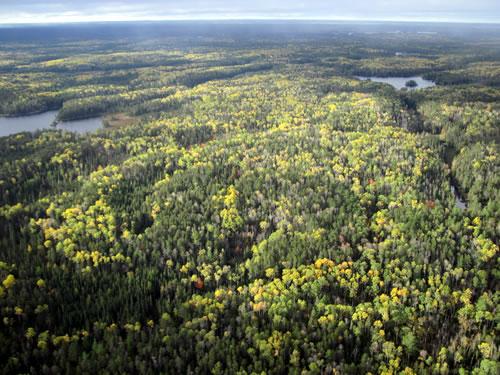
Future of Northern Forests: Insights from Past Management

A new USDA Forest Service report describes how past trends and today's choices might change the future forest landscape in the US North between 2010 and 2060.
Credit: Stephen Handler, USDA Forest Service
“This research is vital to everyone concerned about sustaining diverse, healthy, productive forests and the associated ecosystem services, commodities, and jobs our forests provide,” said Tony Ferguson, Acting Director of the Northern Research Station and the Forest Products Laboratory. “It provides a scientific foundation for exploring and discussing the future of forests, and it underscores the role of management in making forests healthier and more resilient.”
Future Forests of the Northern United States is part of the Northern Forest Futures Project, a cooperative effort of the Forest Service, the Northeastern Area Association of State Foresters and the academic community. Begun in 2009, the project examines how past trends and today's choices may impact Northern forests in coming decades.
The new report is published as General Technical Report NRS-151 by the Forest Service's Northern Research Station and is available online at: http://www.
Change is nothing new to Northern forests, and much of it has been positive over the past century. Since the early 1900s, a period when forests were exploitively logged and cleared for farms, there has been an increase of 11 million acres of forest land and an increase of 144 million cubic feet of timber, both despite a population increase of 26 million people.
However, other changes are causing concern for forest owners and managers: the expanding impact of invasive species, loss of species diversity, low diversity in forest age classes, increasing urban expansion that is shrinking forest acreage, fragmentation of forest land, parcellation of forest ownerships, loss of forest-based employment, effects of burgeoning white-tailed populations on tree regeneration and forest composition, and increasing atmospheric carbon emissions.
“The challenges facing northern forests are large, complicated, intertwined, and enduring,” said Stephen Shifley, one of the 30 authors who collaborated on Future Forests of the Northern United States and a principle investigator for the Northern Forest Futures project.
“By applying the best available science to look ahead at how forests are likely to change over the next 50 years, we think forest owners, managers, planners, and policymakers will be better prepared to avoid many future problems by implementing proactive management practices that are ecologically sound, socially acceptable and economically viable.”
A few of the trends that will affect Northern forests over the next 50 years include:
- Forest area is projected to decrease between 3.5 and 6.4 percent with losses concentrated around existing urban and suburban areas.
- Forest area is currently concentrated in the 40-to-80-year age class and is expected to increase in mean age over time, reducing forest diversity and, with it, important types of wildlife habitat.
- Forests are under the expanding influence of numerous native and invasive insect pests including emerald ash borer, Asian longhorned beetle, spruce budworm, Sirex woodwasp, winter moth, hemlock woolly adelgid, and gypsy moth as well as dozens of invasive plants.
- Aboveground forest biomass is expected to increase by about 4 percent, but total carbon sequestered by northern forests (including soils) is expected to decrease by about 2 percent, primarily as the result of reduced forest acreage combined with slower tree growth that is typical for aging forests.
- Projected population increases in the North are expected to cause Federal and State park land area per capita to decrease by 19 percent and non-Federal forest land area per capita to decrease by 26 percent.
Future Forests of the Northern United States is one of a series of publications examining past, present and anticipated changes in forest biodiversity, productivity, health, soil and water, carbon, biomass, energy, commodities, employment, and recreation in the U.S. North. Other publications are available at: http://www.
The mission of the Forest Service's Northern Research Station is to improve people's lives and help sustain the natural resources in the Northeast and Midwest through leading-edge science and effective information delivery.
The mission of the Forest Service, part of the U.S. Department of Agriculture, is to sustain the health, diversity, and productivity of the Nation's forests and grasslands to meet the needs of present and future generations. The agency manages 193 million acres of public land, provides assistance to state and private landowners, and maintains the largest forestry research organization in the world. Public lands the Forest Service manages contribute more than $13 billion to the economy each year through visitor spending alone. Those same lands provide 20 percent of the Nation's clean water supply, a value estimated at $7.2 billion per year. The agency has either a direct or indirect role in stewardship of about 80 percent of the 850 million forested acres within the U.S., of which 100 million acres are urban forests where most Americans live.
###
USDA is an equal opportunity provider and employer. To file a complaint of discrimination, write to USDA, Assistant Secretary for Civil Rights, Office of the Assistant Secretary for Civil Rights, 1400 Independence Avenue, S.W., Stop 9410, Washington, DC 20250-9410, or call toll-free at 866-632-9992 (English) or 800-877-8339 (TDD) or 866-377-8642 (English Federal-relay) or 800-845-6136 (Spanish Federal-relay).












